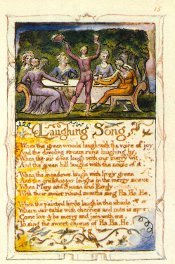Songs of Innocence and Experience Contents
Laughing Song - Synopsis and commentary
Synopsis of Laughing Song

The poem is an invitation to the reader to join in the merriment exhibited by the creation and children at the fecundity of nature in summertime.
Laughing Song is part of the pastoral genre in poetry. It celebrates joy in life and nature, childhood and the unself-conscious budding sexuality. It carries, however, undertones regarding the reality of mortality and loss which is the corollary of life and growth.
Commentary
Laughing Song is an overt celebration of the joys of summer and new life. There is simplicity, zest, youthfulness and growth. The combination of the symbols of fertility, greenness and cherries, together with the sexual associations of the cherry and the ‘sweet, round mouths' of the girls, evokes an environment of unself-conscious budding sexuality and joy in life.
Because of the glory, yet brevity, of cherry blossom, it is often used to symbolise that all life is brief and will end in death. This, plus the cherry's colour, gives another connotation for the cherry, that of mortality. Thus, the imperative to ‘live and be merry' suggests a desire to ‘seize the day' (often referred to by its Latin phrase, ‘carpe diem'), though the innocent speaker may not be aware that there is a darker reason for doing so.
Investigating Laughing Song
- If you had to summarise in a sentence the motive behind the speaker's invitation to the hearer, what would it be?
- Compare your summary with others and justify your answer.
